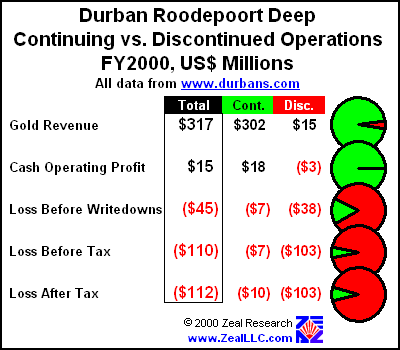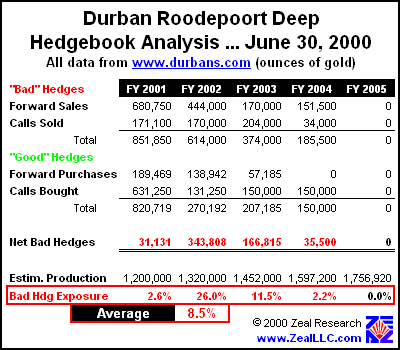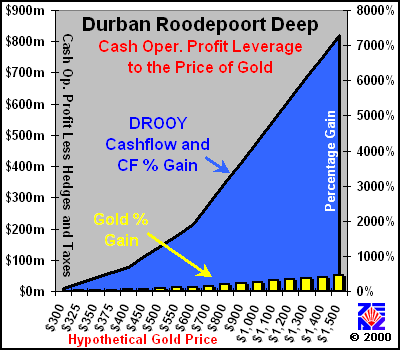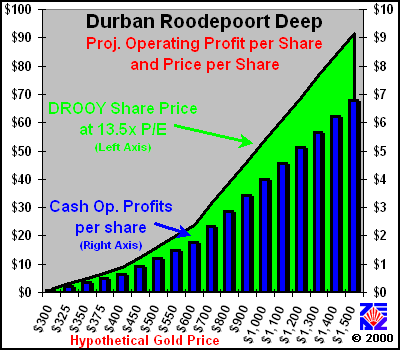|
|
|||||||
|
|
|
|
|
|
|
|
|
|
Roodepoort Rocket Adam Hamilton August 4, 2000 3551 Words
Just as gold aficionados around the world were falling into a deep trance, lulled into a near catatonic state by the inexplicable sub $1 per day trading range in which gold has languished, the little mine that could, Durban Roodepoort Deep, emerged from a knock down drag out battle to climb to the top of the Drakensberg mountains and proudly proclaim its latest annual results to expectant shareholders. Like a warm light at the exit of a long dark mining shaft, the Durban financial results released August 2 provided a bright beacon of hope of great things ahead for the hometown hero company. Following a year riddled with Acts of God, dismal gold prices, and painful asset restructuring, Durban appears to be poised to once again shine bright, with a luster even exceeding that timeless yellow metal it mines.
Before we proceed, an important disclaimer is in order. I am not a professional investment advisor and this essay is not professional investment advice. Investing is an inherently risky activity, contrary to what NASDAQ tech stock investors thought only a few months ago. Investing in any company, can lead to (shudder) loss of capital. (Yes it is true!) Only risk capital, which you would not shed a tear if you lose, should be placed at peril in the unforgiving financial markets. Any investment decision should not be finalized until after you have consulted your personal financial planner, stockbroker, accountant, mother-in-law, and your magic eight ball. Contrary to the popular bubblevision assertion, global equity markets are NOT the equivalent of bank savings accounts. Finally, a very material portion of capital I control is invested in DROOY. My money is where my mouth is… I do not claim to be a disinterested observer. Onward!
Fiscal year 2000, by all accounts, was a very challenging year for Durban. The consolidated group had an accounting loss of US$112m on the year, netting a frightening accounting loss per diluted share of US$0.93. The accounting loss was the result of the dismal gold price and the prudent pruning of non-performing assets by Durban management.
The ancient metal of legend was clubbed down all year, touching 20+ year nominal and real lows near $250 in August of 1999, having an incredibly exciting and brief spike up to the $330 range in September, and then plunging back down to “100% Central Bank Approved” levels of $290 in November. In February, after a high-profile announcement by a major mining company that it was not entering into any future hedging contracts (which many excellent analysts have virtually proven exert a tremendous downward pressure on the price of gold), gold briefly flirted with $320, and then was whacked back down below $290 until it almost hit $270. A brief spike in June to $290 was met with heavy gold selling and leasing by the usual suspects, and gold is currently playing dead under $275. With relatively high cash production costs of $257 per ounce in FY2000, Durban’s cash operating profits were severely squeezed by the anomalously low price of gold. (For comparison, the monthly average closing gold price since 1980 is US$382 per ounce.) After non-cash expenses including depreciation and write-offs were subtracted from operating profits, the large accounting net loss resulted.
As if the comatose gold market was not enough of a challenge, other disasters struck Durban in FY2000. Mere days after the ink on the title deed had dried, the new Hargraves property in Australia was inundated as a deluge of underground water flooded the shafts. The entire property was written off. In a sad note for the sentimental (including me), the venerable namesake mine of the group, Durban Deep, was shut down due to the low gold price and decreasing ore grade. The West Wits shafts were closed, as the ore grade there was also uneconomical at current gold price levels. Finally, the Barison Tropical property was written-off due to the low gold price and perceived political risk. Total asset write-downs throughout the year weighed in at a very hefty US$65m, accounting for almost 60% of the total accounting losses incurred by Durban last year. Durban management aggressively trimmed non-performing assets in FY2000, which, although expensive and painful short-term, will result in vastly increased efficiency and lower cash costs of production in the near future. As the table below shows, the majority of Durban’s positive cashflow came from continuing operations, and the majority of the accounting expenses arose from discontinued operations...
In the small pie graphs in the above table, green represents continuing operations and red represents discontinued operations for the Durban Roodepoort Deep group. 95% of the gold revenue and 100% of the cash operating profit are a result of continuing operations, which will continue to greatly benefit shareholders in the future. Discontinued operations account for a huge 91% of the total losses after tax that Durban incurred in FY2000. As a DROOY shareholder, it is very encouraging to see these non-performing and costly assets written-off to maximize future investor cashflows spun off by Durban.
Interestingly, once all the non-cash items including write-offs and depreciation are excluded from Durban’s consolidated income statement, the results look very encouraging given the incredibly anemic gold price. Although non-cash items are important from an accounting perspective in order to properly match expenses incurred with revenue generated, they are utterly irrelevant from an investor perspective. Any investment is ultimately only worth some multiple of the future cashflows it can provide for shareholders. Accounting for income is largely a creative fiction designed for comparability. CASHFLOWS are the underlying rock solid reality. Over the long run, accounting earnings and cashflows converge, but they can be totally unrelated over the short-term due to Generally Accepted Accounting Principles. This divergence is not an inherently bad thing, as accounting income is designed to provide comparability over multiple companies and time periods and proper matching of revenues and expenses. Ultimately, however, only cashflows matter to the shareholders of a company.
Although large and ugly, the Durban write-offs are not cash expenses. The vast majority of the cash cost of the write-offs was likely already incurred in earlier cash expenditures when the now non-performing assets were purchased. The write-off simply enables the non-cash expense to hit the income statement and flow through the books, eliminating the non-performing asset from the balance sheet. Depreciation is absolutely not a cash expense, and is simply a ghost of capital expenditures past that is not relevant to future investor cashflow. Ignoring the write-offs of non-performing assets, the $43m non-cash depreciation expense, and another $5m of other non-cash expenses, Durban’s CASHFLOW results are very encouraging. Total cash profits for the year for the group were $3m, and annual cash profits for the continuing operations were $8m. The fact that management managed to make cash operating profits of this magnitude with the very unfavorable gold price and tough events Durban faced this year bodes very well for the future of the company and its owners.
The abridged balance sheet released at Durban’s website was fairly sparse, but it indicated a debt to equity ratio for Durban of around 0.32, which is on the high side. This indicates Durban is currently roughly 1/3 debt financed. Durban’s CEO Mike Prinsloo has publicly stated that he hopes to see the ratio go down to 0.20, but he noted the current debt to equity ratio is not out of line with other gold mining operations in the current depressed gold price environment. Durban’s indicated cash position on the balance sheet was only $6m, which is quite low. The reduction in cash available since last quarter (the cash balance was $22m on March 31) is likely directly related to the reduction of the group’s hedge exposure. In interviews, management has indicated they believe the cashflow of Durban will improve dramatically now that the mines losing money have been shut down and written off and Durban can focus on its currently profitable operations in South Africa and its expansions throughout the Australia-Asia region. Cash operating costs for FQ4 FY2000 were reduced to a very impressive US$239 per ounce, and Durban is forecasting future cash costs per ounce in the $220 range. These lowered cash costs will enable Durban to quickly replenish its war chest, even if the charade of abnormally low gold prices is held together with duct tape and bailing wire a little while longer…
Durban’s hedgebook exhibited dramatic improvements in FY2000. The vast majority of Durban shareholders love the company because of its incredible leverage and upward exposure to the physical gold price. It was very encouraging to observe management taking continuing steps to further reduce hedges on the price of gold. With gold near 20+ year lows, and virtually all fundamentals pointing to an imminent and massive rally in the price of gold, now is the time to shed the hedges and position the company to give shareholders full exposure to a gold price that has an immensely higher probability of rising dramatically than continuing to plumb new abysmal depths.
In a gold bull market, there are “bad” hedges and “good” hedges from a shareholder cashflow perspective. Bad hedges include forward sales and writing call options. Forward sales simply involve promising to deliver gold at a future date for a set price. Selling (or writing) call options grants the counterparty to the option contract the right to buy gold at a certain price for a certain period of time. If gold prices are rising, both of these types of hedges can have potentially unlimited opportunity costs for investors. For instance, if gold is trading at $450 per ounce, and a hedging company has a forward sale or written call outstanding at $300, the company is contractually obligated to sell gold at the contract price of $300, well below the spot price. Investors expecting a gold bull market do not want to be burdened with these “bad” hedges. On the other hand, there are also “good” hedges to have in a gold bull market. These instruments are exactly the opposite of the bad hedges, and include forward purchases and call options purchased. With a forward purchase, the hedger can benefit from a rising gold price. For instance, if the hedging company enters into a forward purchase contract at $325, and the market price of gold rises to $375, the hedger can buy gold per contract at $325, and immediately sell it in the open market for $375, netting shareholders a quick $50 per ounce profit. Purchasing a call option has very similar potential effect, except the option may be exercised at any time over a contractual period of time, and not only on a specific date. If a company buys a gold call option at a strike price of $350, and gold runs to $600, the company has the right to purchase gold at $350 and immediately sell the gold in the open market at the new market price, yielding a $250 per ounce profit in this example. Durban Roodepoort Deep’s current hedgebook consists of both good and bad hedges for the coming bull market in gold. Good hedges can be used to offset bad hedges, resulting in more exposure to upward movement in the price of gold for Durban shareholders. The table below outlines the current state of the company’s hedgebook.
Although this analysis is simplified (specific hedge strike prices are not modeled, for instance), it provides a materially accurate view of Durban’s current hedge exposure. The specific ounces hedged are from Durban’s website, but the estimated production in future years is a hypothetical creation. Future estimates of production are based on a very conservative 1.2m ounces produced in this new fiscal year, growing by 10% compounded annually for the following years. (Actual production in FY2000 was 1.1m ounces, a stunning 74% higher than the previous year’s 633k ounces.) In addition, purchased put options are not considered in this analysis. Purchasing put options gives Durban the contractual option to sell gold at a certain price in a defined future timeframe. When gold runs, these options will not be exercised and will simply be allowed to expire. The cash cost for the put options is already sunk, and is immaterial to negative hedge exposure. Overall, as the above table shows, Durban’s net bad hedges are very modest and management has improved the hedgebook dramatically over the past year. On average, net bad hedge exposure for a gold rally is a very low 8.5% over the next five years. Fiscal year 2002 (July 2001 to June 2002) currently has the highest exposure, but Durban management has publicly stated that the hedge positions will be further reduced as market conditions permit. Global gold investors should not underestimate the significance of this reduction of the hedgebook. It demonstrates Durban management is bullish on the price of gold and is actively striving to maximize shareholder participation (and subsequent wealth creation) in the coming gold bull market. Mr. Prinsloo, in a recent interview with Moneyweb, indicated management conservatively believes the gold price will move through $300 in the near future, and then regroup at the $310 to $320 level. As a shareholder, it is incredibly reassuring to have capital invested in a gold mining operation that ACTUALLY BELIEVES gold is set to rise in price. Unfortunately, many gold mining companies around the world are hedged to the hilt, and they believe the hollow propaganda of the bullion and central bankers that gold is a “barbaric relic” and destined to trend down to a price of zero. They are, of course, dead wrong, and Durban management realizes this and is rapidly positioning Durban to surf high on the face of the coming gold tsunami.
Congratulations on staying awake this long! We have finally made it through the tedious accounting ramblings and arrived at the crux of the issue. LEVERAGE! The stuff of which returns of legend are made! Durban Roodepoort Deep is one of the most highly leveraged gold mining operations to increases in the price of gold on the entire planet. Durban is like the ultimate call option on the price of gold, but is far superior, as it never expires. Ultimately, an investment is only worth the future cashflow streams it can spin off. The following analysis of Durban’s phenomenal leverage to the price of gold uses net operating cash flow generated as a proxy for future earnings. FY2000 results were recalculated with hypothetical higher gold prices. Nothing was changed in the financial numbers except the selling price of gold produced last fiscal year. The results will warm the hearts of beaten down gold lovers everywhere…
As Durban shareholders have come to expect, DROOY’s leverage to the price of gold is simply extraordinary. The yellow bars on the graph above show the percentage increase in the price of gold from current levels, and the blue wedge outlines the mind-boggling percentage increase in operating cashflows (and actual cash generated … left axis) that would result for Durban at various higher gold prices. The hypothetical projections are very conservative. Operating cashflows were decreased by the average 8.5% negative hedge exposure discussed above and an arbitrary tax rate of 33% was deducted from the cashflows to simulate South African corporate income tax. The ONLY number changed from FY2000 financials was the price of gold. In addition, when these levels of gold prices storm onto the scene in the real world, Durban has many mining properties that have cash costs per ounce too high to be profitable at current price levels. When these other marginal mines are brought online in response to the fledgling gold rally, Durban will be able to increase production dramatically, which will radically ratchet up the conservative leverage of operating cashflows to the price of gold modeled above… So what potential effect will all that leverage have on the Durban share price, you wonder?
Once again, using operating cashflows as a proxy for earnings and dividing by the 121m diluted shares outstanding yields this graph. The blue columns represent operating cashflow (the same conservative numbers presented above) per share generated by Durban, and the green wedge outlines the share price for DROOY as valued by the historical average stock market P/E ratio of 13.5. As this graph makes blatantly evident, DROOY’s current price of US$1 per share is an unbelievable bargain, especially as the coming gold bull market begins to unfold. The fact that the entire company is trading at US$120m, worth less than Bill Gates’ house, is an incredible oversight by the equity markets that WILL soon be corrected. (Please don’t take my word for it, double check the math and do your own due diligence! The Excel 2000 spreadsheet that generated these graphs is available for all seekers. Please e-mail me for a copy.)
The projected valuation at 13.5x earnings noted in the graph above is also incredibly conservative. When the neo-gold rush commences, investors will bid highly leveraged gold mines up to fantastic valuations, far exceeding all limits of rationality. Gold rushes DEFINE speculative manias! If Cisco Systems, which makes simple commodity internet routers, has no significant barriers to entry for competitors, only earned $2b last year, and is currently valued at the mind-boggling 190x earnings level, can spark investor interest and lead to mania valuations, wait until we see what a new gold rush will spawn. Gold is the timeless asset of kings and empires, and virtually no one is immune to its seductive allure once they have held the magical yellow metal in their own two hands, feeling its mighty weight and being dazzled by its luminous glow. Our psyches and culture are still fraught with gold idioms, and the seeds have been sown for a massive new public gold lust to unfold like a firestorm in a parched wilderness once the gold price begins moving. After all, have you ever heard of an “internet” medal in the Olympics, or “I am “biotech”” when someone is doing well, or a high-class “web” credit card? There is no rush like a gold rush, and the speculative excesses we will see as unlimited capital begins to chase very finite gold mining operations around the world will be awe inspiring. Highly leveraged gold mining operations will be bid up to dizzying heights as investors clamor for a piece of the exciting action.
And there is no doubt the gold rally of legend is rapidly approaching. Although physical gold fundamentals are outside the scope of this essay, Gold Eagle (www.gold-eagle.com) is full of brilliant essays from analysts all over the world carefully analyzing the positive fundamentals of gold from a myriad of perspectives. Regardless of from what angle one analyzes the current gold price, the inevitable conclusion reached is the metal is terribly undervalued. One of the greatest things about Durban is it is a survivor, and will absolutely last until the neo-gold rush begins in earnest. The company has been in business for over 100 years. (Only one of the original Dow 30 companies has remained in the index over that same time period!) Durban just reported gold reserves exceeding 15m ounces, increasing nearly 15% over the last 12 months. At the estimated future production levels noted above, these reserves will last for another decade even IF new reserves are not added. The Durban group also has 87m ounces in resources, which can be tapped as the price of gold rises. These resources are currently too expensive to mine profitably, but in the coming gold bull market, new higher and higher gold equilibrium prices will be established, making many currently unprofitable resources evolve into profitable reserves. Even if the powerful anti-gold forces are able to keep their anti-gravity fiat levitation scam going a little longer, there is no doubt Durban will survive and even thrive until gold unshackles itself and once again violently seeks its true value. (I have friends who were invested in Durban in the 1970s during the last gold rush, and they were receiving more cash in QUARTERLY dividends from Durban than the share price they initially paid for the company!)
As a final bonus, Durban just threw up a hip new website with the announcement of last year’s results. The website, at www.durbans.com, is sure to appeal to the Internet savvy NASDAQ crowd. As they watch their grossly overvalued technology companies plummet to the ground like fiery meteors at Armageddon, they will be desperately looking for a safe haven to preserve any capital they are able to hold on to as they bail out of the imploding bubble. We Durban investors, will, of course, welcome them with open arms!
As gold rises and the Roodepoort Rocket is ignited, investors around the world will scramble for scarce seats before the liftoff begins. The spoils that will accrue to the courageous and the tenacious in the coming gold bull market will be of legendary magnitude, and Durban will lead the fleet of gold companies as they pass through the stratosphere to stellar and potentially once in a lifetime returns.
The countdown commences! 5 … 4 … 3 …
Adam Hamilton, CPA August 4, 2000 |
|||||||
|
|
|
|
|
|
|
|
|
|
|
|
|
|
|
|||




